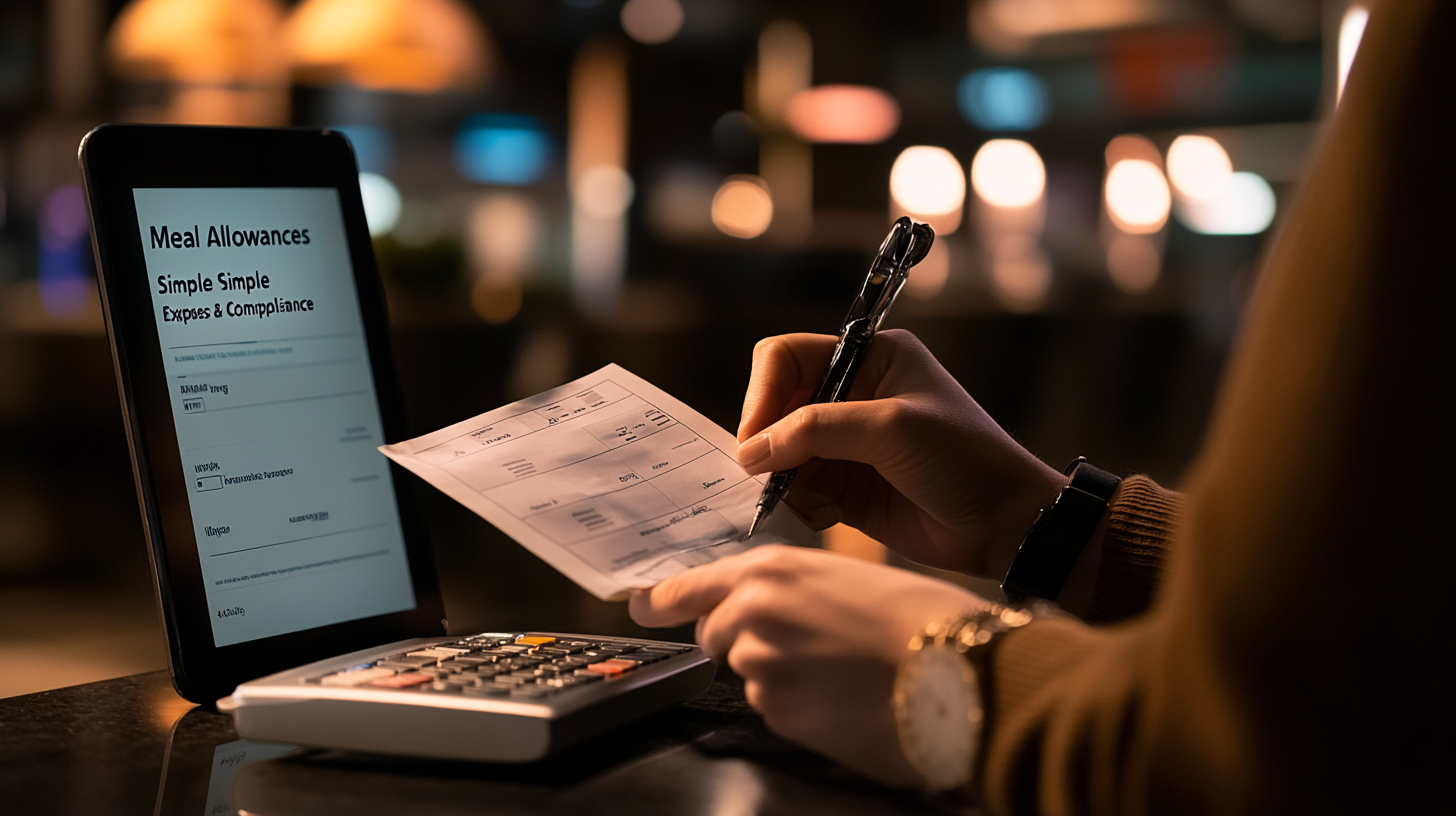Meal Allowances Made Simple: A Frequent Flyer’s Guide

I’ve spent countless hours cruising above the clouds, watching the world unfold beneath me. And trust me, when it comes to business travel, meal allowances are one of those details that can make or break a trip. By understanding how these allowances work—from official per diem rates to in-house policies—you can keep your focus on snagging a window seat, rather than fretting over food costs.
1. Understanding Per Diem Basics

Per diems are designed to simplify travel planning. Instead of storing every meal receipt, I get a single allowance that covers my daily food and incidental needs, no matter how many airport connections I make. In my experience, the convenience is unbeatable when you’re hopping from city to city on a tight schedule.
A recent industry survey found that companies using per diem systems reported a 30% decrease in administrative overhead for travel expenses. That’s a big deal for travelers and finance teams alike. By applying a consistent daily rate, budgets stay predictable, and everyone knows what to expect. Still, it’s important to confirm that your company’s chosen rate is fair for the location you’ll be visiting. Grand Rapids might have more modest meal costs than a weeklong stay in San Francisco, after all.
In my own travels, I’ve noticed that the biggest advantage of per diems comes during multi-stop trips. You stay flexible, cover all your meals without fuss, and skip the hassle of daily reimbursements. It’s a strategy that’s saved me plenty of time—which I’d rather spend choosing the perfect seat in the boarding area.
2. Government Guidelines & New Updates

Following official guidelines can ensure you remain on the right track. According to the U.S. General Services Administration (GSA) for Fiscal Year 2025, standard lodging rates sit at $110 per night, with meals and incidental expenses capped at $68 per day. I’ve noticed these figures can shift annually, so marking your calendar for mid-August is wise—rates typically update then and take effect on October 1.
If you spend time in Non-Standard Areas—around 300 localities that tend to have steeper living costs—you’ll find higher rates. This can be a lifesaver if you’re headed to major cities. Federal guidelines typically handle most of the continental U.S., while the Department of Defense and Department of State set allowances for Alaska, Hawaii, and oversees foreign destinations. I always double-check the current tables on official websites before I take off, especially if I’m venturing abroad.
A recent study suggests these government rates are closely watched by both public and private sectors, meaning many corporate policies align closely with GSA benchmarks. When you’ve traveled as much as I have, you quickly learn that staying informed on official numbers helps you avoid the nasty shock of being short on meal funds in pricier locales.
3. Company-Specific Meal Allowances

Every organization approaches meal allowances differently. I’ve flown for companies that reimburse every penny of actual expenses (provided you supply a receipt), while others prefer daily flat rates—often somewhere between $30 to $50 in the U.S. There’s also the matter of international affiliates. I’ve observed how a firm operating in China might offer allowances of around RMB 120 ($20) per day in certain provinces. This variability demonstrates why travelers should keep an eye on local norms.
According to industry data, about 40% of U.S. businesses use strictly per diem plans tied to GSA guidelines. Others build custom policies, mixing reimbursements with lumpsum allowances to match both corporate budgets and employee comfort. When I’m planning flights, I always check the company’s travel portal. It’s a simple step that ensures I know whether I’m dealing with a per diem or receipt-based system before I land.
From what I’ve experienced, the sweet spot often lies in a clearly communicated, well-structured policy. If the plan is too vague, you risk confusion, mismatched expectations, and frustration on both sides. Setting a realistic daily meal budget means minimal guesswork and maximum focus on the actual journey.
4. Tracking Expenses & Compliance

While per diems reduce clutter, accurate documentation still matters. One of the biggest headaches in business travel can come from incomplete or erroneous paperwork, so I always keep a personal log of my flight dates and destinations—even if the official policy doesn’t require itemized meal receipts. This approach has spared me countless phone calls with finance departments.
The Internal Revenue Service (IRS) will occasionally spot-check travel expense claims, which is why it pays to be thorough. I’ve found that using expense management software such as itilite, Concur, or similar apps can be a game-changer for simplifying compliance. Checking the updated GSA rates—like the 2024–2025 shift noted earlier—also ensures you’re staying within the right brackets. Accuracy here means smoother audits and less stress down the road.
Another tip: consult a tax advisor if you’re unsure about anything. Travel tax rules can be murky, especially if you cross several tax jurisdictions in a single year. In my own practice, asking for professional advice has saved me long-term headaches, ensuring I never miss a potential permissible deduction or misclassify an expense.
5. Enhancing the Travel Experience

In my mind, meal allowances go far beyond just food. Well-structured policies can actually enhance the journey. I’ve seen some companies offer flexible meal stipends through programs like Benepass, letting you pick dining options that suit your cravings—be it a fresh salad for lunch or leftover pizza for a late-night check-in. Morale matters, and having control over what I eat on the road has made a difference during long-haul excursions.
When traveling in a group, well-managed meal allowances can foster camaraderie, too. Colleagues get the chance to dine together and bond over new cuisine without worrying about who’s footing the bill or whether the expense will be approved. It’s a small detail that can have a lasting impact on team spirit, whether we’re working in cozy airport lounges or connecting virtually from different cities.
In the end, a balanced meal allowance policy reflects a company’s respect for its traveling employees. Time and again, I’ve found that putting a bit of thought into budgets and compliance paves the way for a smoother, more focused trip. And if I manage to score that perfect seat with extra legroom, so much the better.
Final Thoughts
From my vantage point at 35,000 feet, I’ve learned that meal allowances hinge on research, planning, and clear communication. By understanding per diem basics and staying on top of government updates, you can save yourself the headache of sorting through endless receipts. Many companies offer flexible, tailored arrangements that simplify budgeting and tracking, ensuring your focus remains on the purpose of the trip.
A trained eye on compliance also never hurts. Even with a per diem in your back pocket, accurate record-keeping can spare you unwelcome audits. Whether you’re traveling globally or staying local, the more you know about the process—government rates, company policies, tracking software—the less friction you’ll encounter. Ultimately, a sensible meal allowance strategy can elevate the entire travel experience.
Ryder’s Take
Throughout my travels, I’ve relied on supportive meal allowance policies, and they’ve proven to be more than just a line item on an expense report. Tailored approaches that fit each trip’s unique challenges let you savor every flight without worrying about how you’ll pay for dinner when you land.
As a dedicated seat strategist, I’m always seeking ways to streamline the behind-the-scenes details so I can focus on what really matters: enjoying the ride, staying productive, and sharing my findings with fellow frequent flyers.
Seat5A has you covered for more tips, insights, and travel inspiration.






